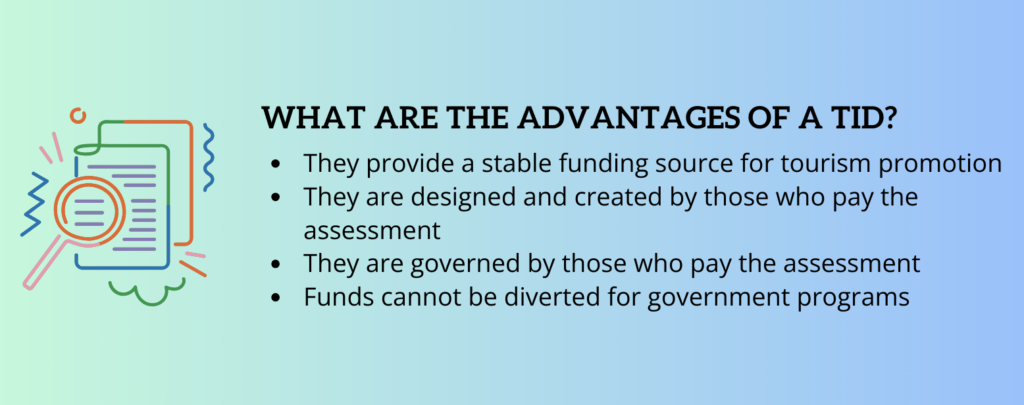- In a sense international DMOs operate with dysfunctional funding models.
- The big new thing in America is Tourism or Business Improvement Districts (TIDs or BIDs.)
- It is arguable that the hardest part of forming an improvement district is the legislative part.
At a recent international conference, I stood in front of a room full of people from convention bureaus and asked them to raise their hands if they had more money than they needed. Yes, the question was rhetorical and while a communal chuckle went up, no hands did.
Had I asked that question in the United States, there might have been a different reaction. Because every year in the US there are bureaus that have received millions of dollars in new funding overnight. And in some of those instances it’s a bit like the dog catching the car – what now?
Naturally, when a bureau gains a large funding increase it will seek the most effective ways to invest those resources. But, sometimes the funding really does come so fast that there are no fully developed plans on what to do with it. How is that possible? More on this later.
We tend to have the opposite problem in the rest of the world. If our bureaus are surprised by changes in their funding, it’s usually a source of great disappointment. That’s because most bureaus outside of North America operate in a hand-to-mouth fashion. The government is the hand that feeds and when governments encounter budget problems DMOs are often first-in-line targets for cut-backs. With international DMOs, most of us “dogs” are endlessly chasing, but don’t ever get to catch the car.
Internationally, DMO funding models are irrational
In a sense international DMOs operate with dysfunctional funding models. Bureaus are left begging for budgets every year from politicians who really don’t understand or adequately value our industry. Policy makers generally don’t associate quantifiable returns on investment for the promotional funding they deliver. So, it’s a matter of faith that there’s a correlation between levels of sales and marketing and resulting levels of business. Without strong faith there’s limited appetite for making greater investments, and frequent motivations for reducing them.
Internationally, market success doesn’t tend to correlate with market resourcing. It can even be so irrational that the policy calculus can be “business is so good, the DMO doesn’t really need all the money they have.” After all, governments are fundamentally problem solvers. So, if there’s no problem why spend money on it?
Is America showing the way?
Now, back to America. Most CVBs in the US have a rational funding model – it’s called a dedicated hotel room tax. If bureaus help build visitation, the tax collections rise and their budgets grow. That all started about 50 years ago and American bureaus grew accustomed to dependable revenue streams and healthy budgets, in many cases in the tens of millions of dollars. But to return to the “hands in the room” metaphor, unless they’ve recently gotten a large boost in funding, most bureaus in the US would say they need more. After all, they do operate in an intensively competitive domestic market. So, in the past 10 years or so over 200 of them have figured out a way to get more.
The big new thing in America is Tourism or Business Improvement Districts (TIDs or BIDs.) The concept is relatively simple. Define a district, for instance a central tourism precinct or a convention precinct, with lots of hotels around it. Work with the hotels to see if there’s an appetite for a joint promotional effort. The motivating factor is for them to increase their REVPAR. In a progressive hotel community there is usually an openness to collaborate on building a stronger business environment.

How Boston went from an $8 M budget one year to $32 M the next
The key to an improvement district is that the funds can be generated from hotel guests rather than from the hotels themselves. That’s because the usual funding mechanism is a 1% or 2% levy on guest stays. So, by agreeing to be part of the cooperative marketing program, hotels can benefit significantly and not really even have to make an investment.
The key to creating an improvement district is having enabling legislation for a local municipality, state or province to implement the levy because of the practical need for a “collection authority.” But, the other key is for the enabling legislation to require that the hotels who support the levy have control over the use of funds. This can be accomplished by the legislation specifying where the proceeds go. Depending on local practicalities that’s usually an independent incorporated hotel marketing alliance or a specific DMO.
So, the joy of an improvement district is that it can generate a large and dependable revenue stream for building tourism and/or convention business and the hotels don’t even have to pay for it. That’s why hotels in the US have so consistently supported these levies.
It is arguable that the hardest part of forming an improvement district is the legislative part. However, the US had a lot of success because local citizens are not being “taxed” and because the hotels actually helped lobby for the levy.
So, yes, Boston is an example of a recent new TID city. 2 years ago the bureau’s annual budget was about $8 M USD. A year later it had a TID and its budget went to $32 M USD.
Start with a few, the rest will follow
Is the TID or BID model replicable internationally? My guess is that it will be a challenge. But that the rest of the world might be able to follow the American example. There it started with one bureau in California, then the other California cities wanted it. Then the rest of American cities wanted it. In the American experience, once a few were accomplished, there was a massive chain reaction.
Could improvement districts be a new frontier of rational promotional funding where DMOs don’t have to do the annual dance with policy makers? Can there be a few global leaders who start a chain reaction? If so, it would transform our industry.
Let me know if you have any comments or want to discuss further.
GainingEdge has formed a partnership with Civitas, the California based consulting firm that supported the creation of over 200 improvement districts in the US. Our goal is to help drive progressive funding policies that will strengthen DMO’s globally.
The article has also been featured in the latest issue of MICE in Asia magazine – Issue 4 October/November/December 2024 (page 28-29). Click here to access the issue.
